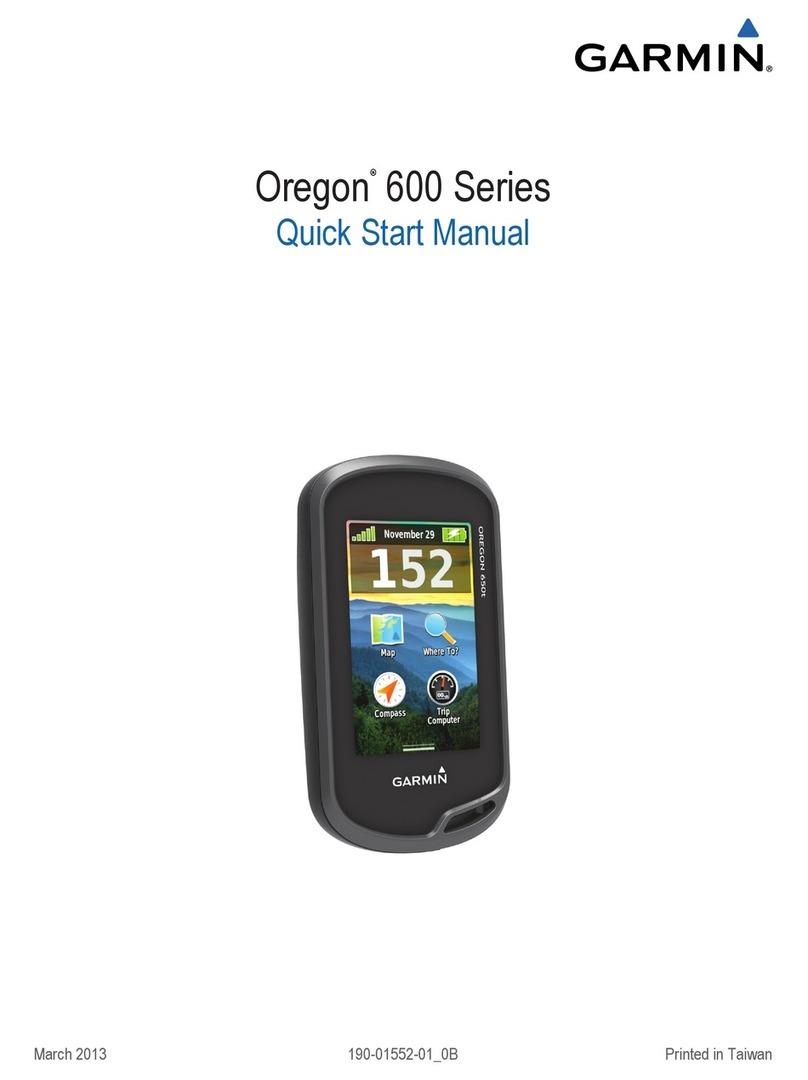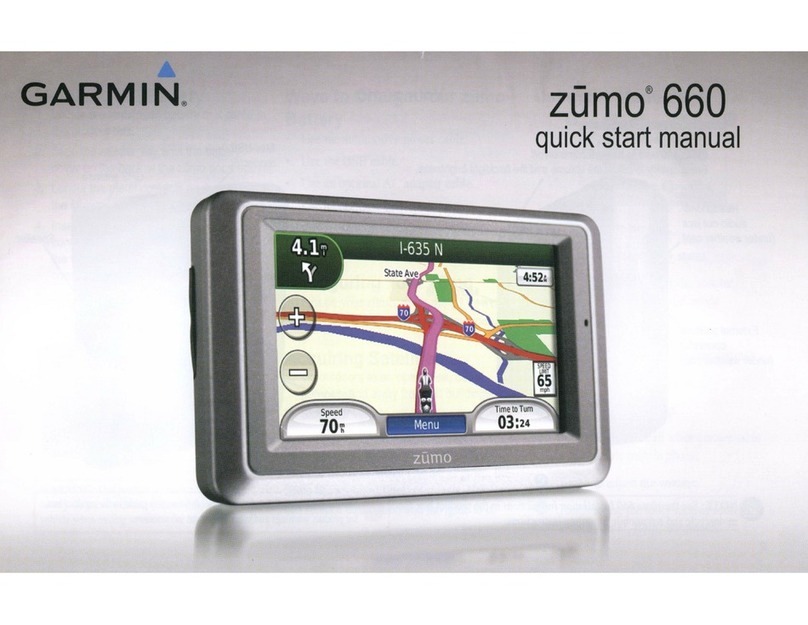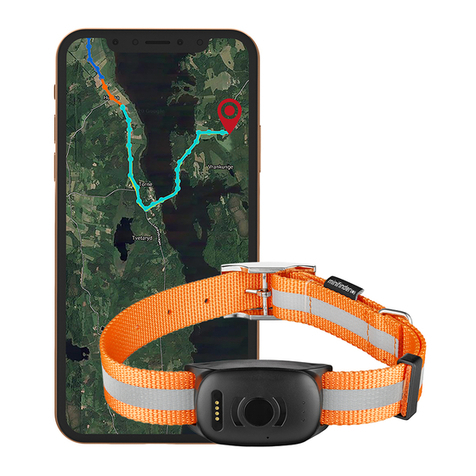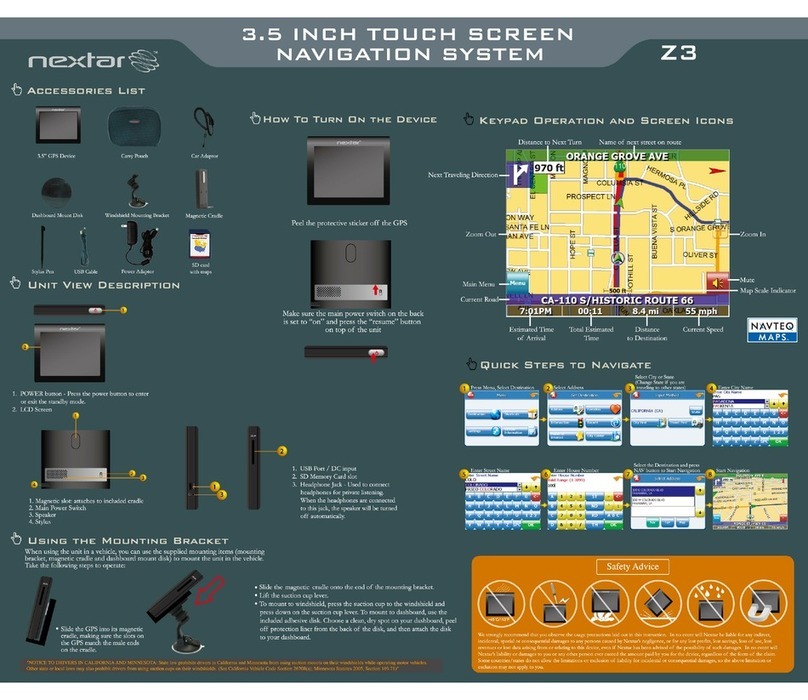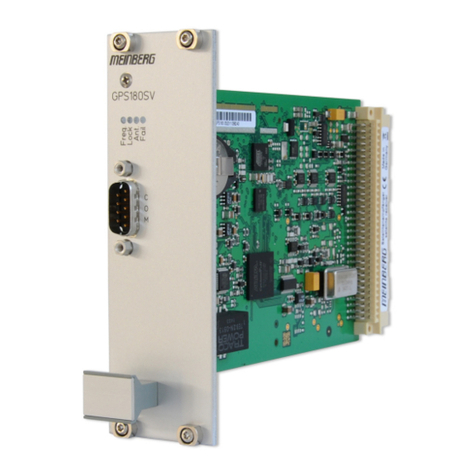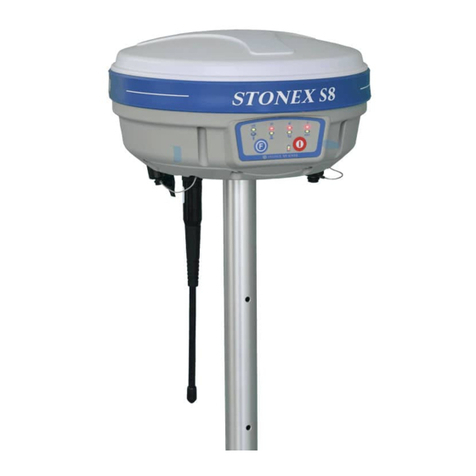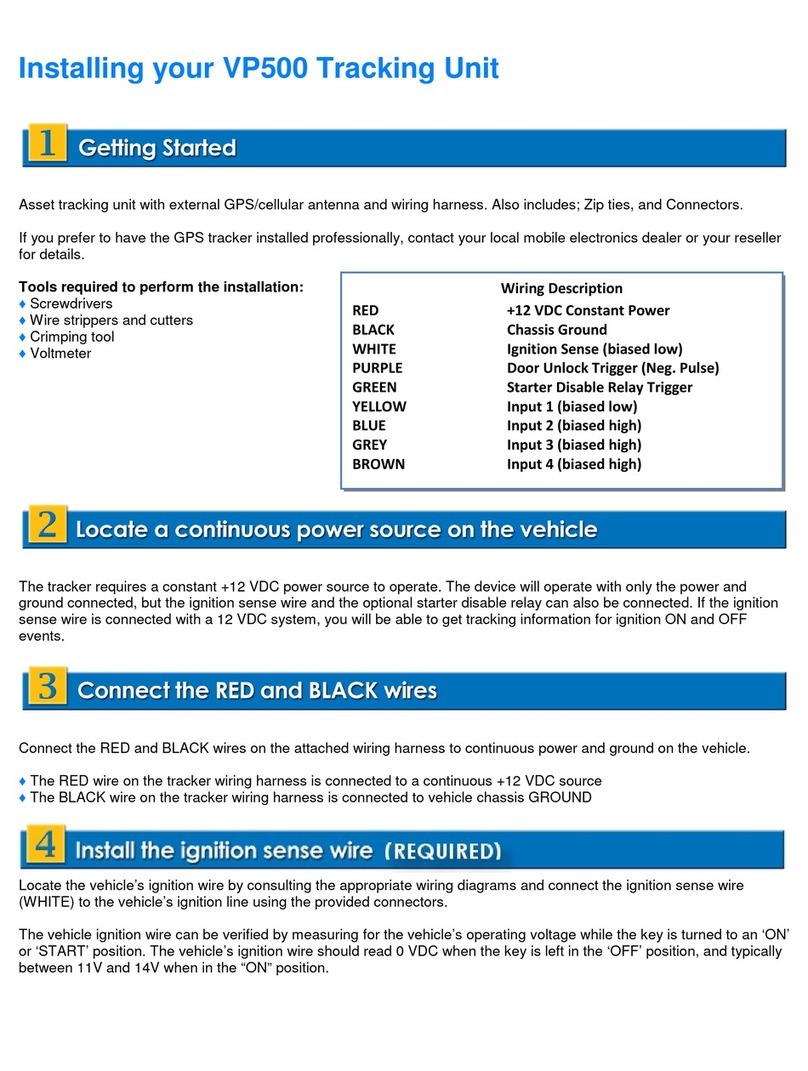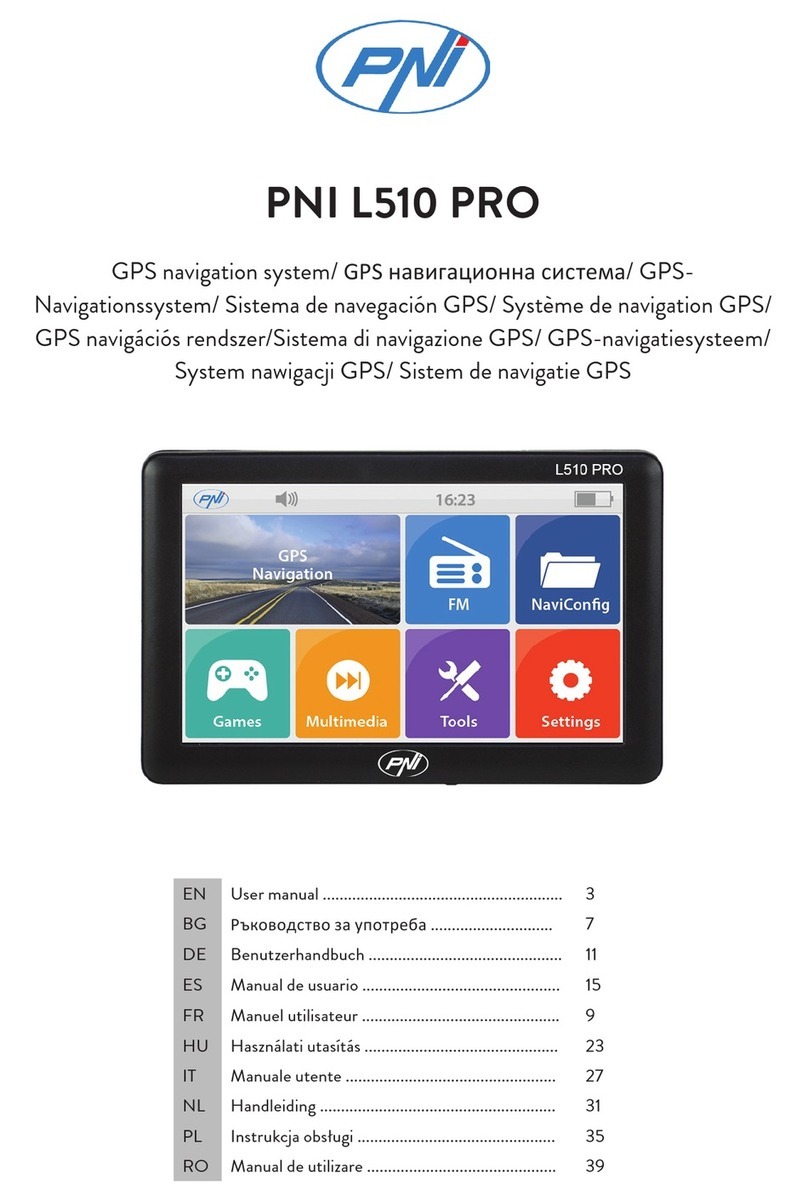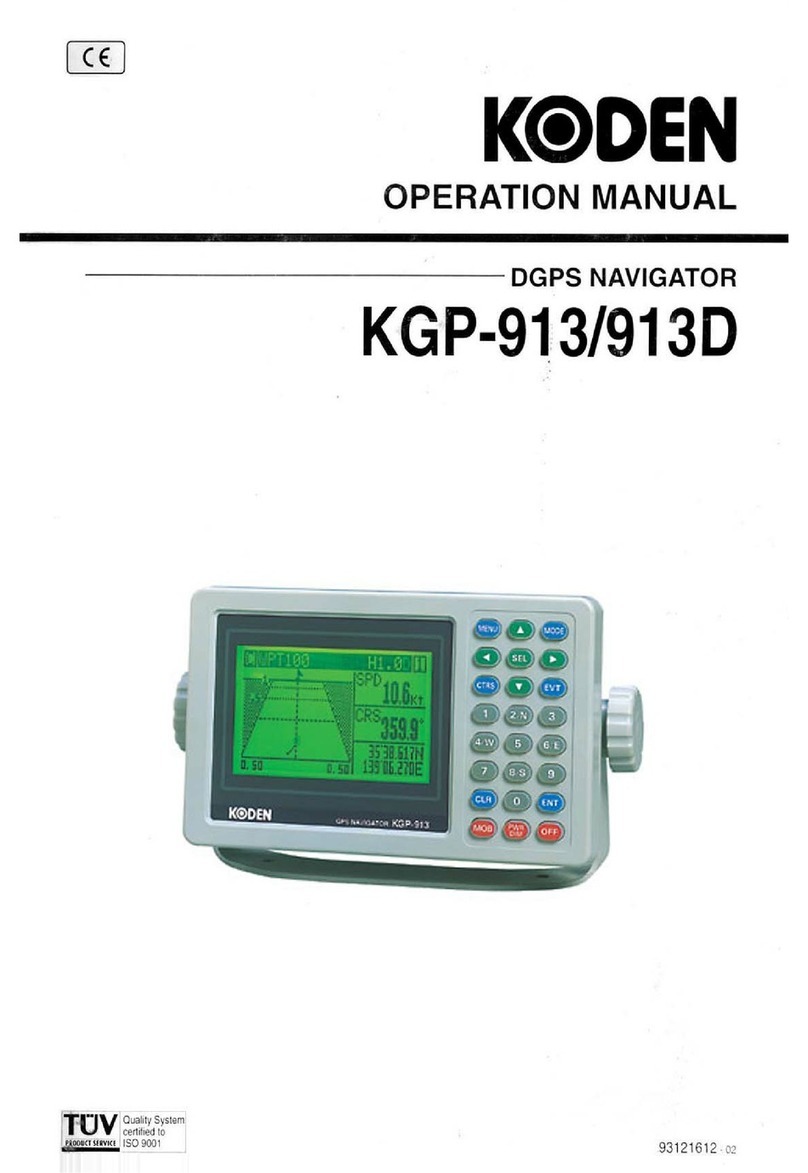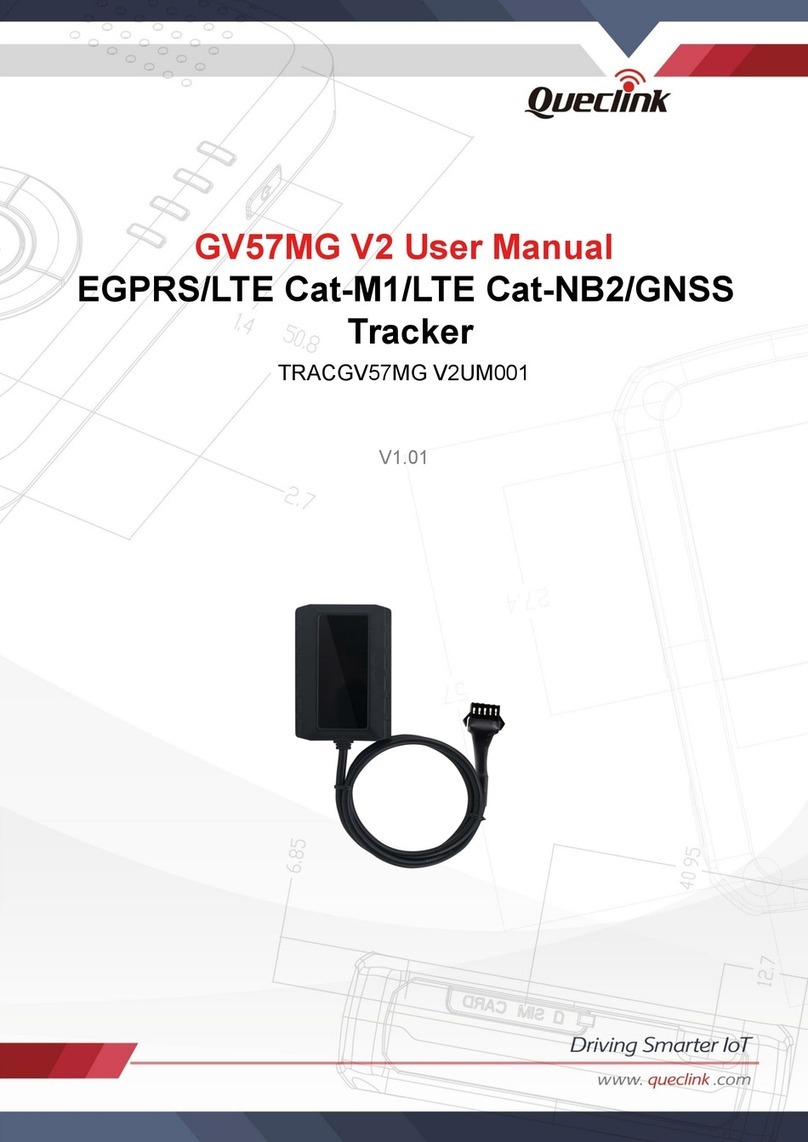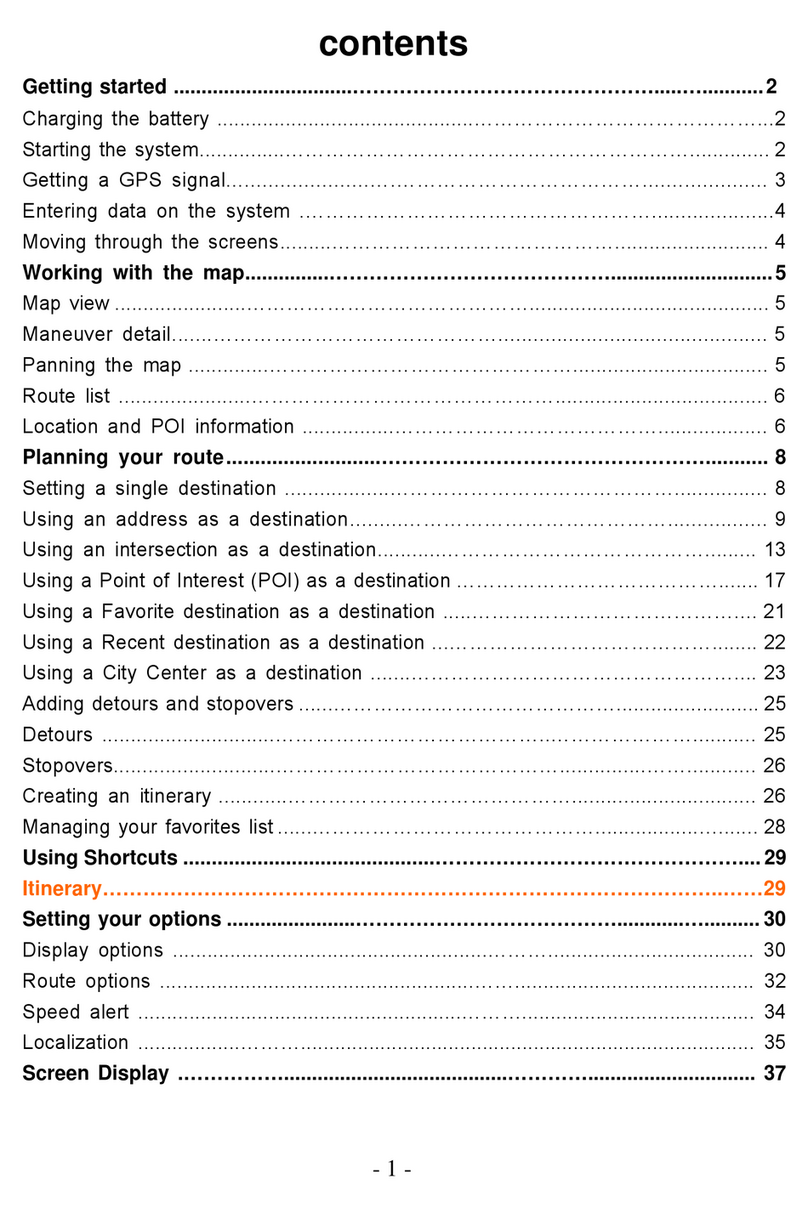Teletrac Prism TM Service manual

Prism TM
Teletrac Prism TM
Information and Installation
Desired Learning Outcomes
At the conclusion of this module you will:
Know the physical components that make up a Prism TM
installation
Know the current feature set of the Prism TM
Know the components and processes used to acquire and
transmit Prism TM information
Know the requirements and processes to install and test a
Prism TM

Teletrac, Inc. - Prism TM Information and Installation Guide
2 1622-0300 B1 3/18/04

Teletrac, Inc. - Prism TM Information and Installation Guide
1622-0300 B1 3/18/04 3
KEY PERFORMANCE INDICATORS
With no direct supervision and with written guidelines, the
Prism TM installer will be able to:
Describe the peripheral equipment used in a Prism TM
installation
Identify the internal components that make up a Prism TM
Describe the method of how a Prism TM determines its
location
Identify what information the Prism TM can communicate
when different systems are hindered
List current features of the Prism TM
List the steps to replace a VLUplus with a Prism TM
List the steps to initially install a Prism TM

Teletrac, Inc. - Prism TM Information and Installation Guide
4 1622-0300 B1 3/18/04

Teletrac, Inc. - Prism TM Information and Installation Guide
1622-0300 B1 3/18/04 5
Table of Contents
Introduction .................................................................................................................................................. 7
Physical characteristics ................................................................................................................................ 7
PRISM TM ................................................................................................................................................... 7
ANTENNAS .................................................................................................................................................. 8
PERIPHERALS .............................................................................................................................................. 8
The GPS and GPRS Systems....................................................................................................................... 9
GLOBAL POSITIONING SYSTEMS (GPS)....................................................................................................... 9
GPRS........................................................................................................................................................ 14
THE OVERALL TELETRAC PICTURE ........................................................................................................... 15
SUBSCRIBER IDENTITY MODULE (SIM) CARD .......................................................................................... 17
Prism TM Functionality............................................................................................................................. 19
DEFAULT SETTINGS................................................................................................................................... 19
Feature Comparison................................................................................................................................... 21
COMPARISON CHART ................................................................................................................................21
PRISM TM FEATURES DEFINED ................................................................................................................ 22
Long Inbound Messaging ..................................................................................................................... 22
Scheduled Locations............................................................................................................................. 22
In Motion detection............................................................................................................................... 24
Speed Threshold ................................................................................................................................... 25
Dynamic Power Management .............................................................................................................. 25
Message Store and Forward (Message History) .................................................................................. 26
PRISM TM Installation Instructions .......................................................................................................28
PRE-INSTALLATION CONSIDERATIONS ......................................................................................... 28
ITEMS REQUIRED FOR PRISM TM INSTALLATION.................................................................................... 29
WIRING SCHEMATIC.................................................................................................................................. 29
ANTENNA PLACEMENT.............................................................................................................................. 30
PRISM TM INSTALLATION PROCEDURES ................................................................................................ 32
SWAPPING OUT A PRISM TM...................................................................................................................... 34
Prism TM Administration & Provisioning............................................................................................... 36
Appendix A – An Introduction to Global Positioning Satellite Systems................................................ 40
Appendix B – Teletrac Prism TM Antennas............................................................................................ 50
Appendix C – Installation Equipment ...................................................................................................... 52
Appendix D – How Messages Are Used In Scripts .................................................................................. 54
Appendix E – Pinouts for Standard Teletrac Harness ............................................................................ 60
Appendix F – FCC Statement.................................................................................................................... 62
Appendix G - Safety Information.............................................................................................................. 63

Teletrac, Inc. - Prism TM Information and Installation Guide
6 1622-0300 B1 3/18/04

Teletrac, Inc. - Prism TM Information and Installation Guide
1622-0300 B1 3/18/04 7
INTRODUCTION
Welcome to Teletrac’s Prism TM Information and Installation Guide. The goal of this guide is
to give you an understanding of how the Prism TM functions and how the different systems it
uses function, as well as, how to install the Prism TM itself. As you make your way through this
guide, you will start to become familiar with many aspects of the Prism TM, however, nothing will
replace the hands-on experience of installing a unit and seeing how it functions in person. It is
hoped that you will use this guide as a reference to give you guidance whenever a problem is
encountered.
This guide starts with a discussion of the physical characteristics of the Prism TM and the
equipment it requires to function. Next is a brief introduction to the systems the Prism TM relys
upon to do it’s job. After that will be a feature list to compare the Prism TM to an RF & CDPD
VLU along with descriptions of the features. Lastly is a section on how to install and test the
Prism TM. Now, let’s get going…
--------------Unit One--------------
PHYSICAL CHARACTERISTICS
PRISM TM
The Prism TM is a custom built
transceiver made for Teletrac. The
device is a black anodized
aluminum box roughly the same
size as a CD carrying case.
Internally it consists of a GPRS
modem, a GPS receiver, a
controller board and a SIM card.
The GPRS modem and GPS
receiver are basically off-the-shelf
devices. It’s the SIM card that
makes this product unique.
The SIM (subscriber identity module) card is a small electronic board
that contains the “personality” of the unit. The SIM is a programmable
card that can easily be moved from one unit to the next so that in the
event of hardware failure the card can be remove and placed in a new
unit without any reprogramming. SIM cards and the GPRS system run
on the GSM network which is considered to be one of the most secure
communication systems since both data and voice are encrypted to
prevent eavesdropping. See Section Two for more information about
how GSM, GPRS and SIM cards work.
In theory, the Prism TM should work about the same as a VLUplus. It
has been purposefully designed to have a similar wiring scheme and
to use the same installed peripherals. See Unit Five for installation
information.

Teletrac, Inc. - Prism TM Information and Installation Guide
8 1622-0300 B1 3/18/04
ANTENNAS
The Prism TM uses a hidden combo antenna or roof mount combo antenna. In the future there
will be more antenna options once the physical connector has changed.
Combo Hidden Antenna
Roof Mount combo Antenna
PERIPHERALS
MDT
The Prism TM is designed to use the same peripherals or accessories that the RF and CDPD
VLU uses. In addition to the same peripherals, the Prism TM currently has two inputs and two
outputs. Input 0 is configured to work with ignition on/off and inputs 1 & 2 allow for the connection
of PTOs.

Teletrac, Inc. - Prism TM Information and Installation Guide
1622-0300 B1 3/18/04 9
--------------Unit Two--------------
THE GPS AND GPRS SYSTEMS
There are two systems that the Prism TM uses outside of the Teletrac system. One is the Global
Positioning System, more commonly called GPS and the other is the General Packet Radio
System otherwise known as GPRS. The following pages will give you a basic introduction to
where these systems came from as well as how they work. At the end of this section will be a
summary of how Teletrac uses these two systems together to get the location of a vehicle.
GLOBAL POSITIONING SYSTEMS (GPS)
The following information was taken from information posted to the Teletrac Intranet. Included
here is the abridged version of GPS. The full text appears in Appendix A at the end of this
Information Guide.
AN INTRODUCTION TO GLOBAL POSITIONING SATELLITE SYSTEMS
Global Positioning Systems
GPS uses "man-made stars" or satellites as reference points to calculate positions on Earth
accurate to within meters. In fact, with advanced forms of GPS you can make measurements to
better than a centimeter. In a sense, it's like giving every square meter on the planet a unique
address.
Since GPS receivers have been miniaturized to just a few integrated circuits and have become
very economical, the technology has become increasingly accessible.
Here's how GPS works in five logical steps:
Here is a summary of each of the steps involved with GPS in order to determine a location. This
is the first part of Teletrac finding the locations of vehicles using a Prism TM. Once a location is
determined then it is sent via another system. We'll explain each of the following points in the
next five sections.
1. The basis of GPS is "triangulation" from satellites.
2. To "triangulate," a GPS receiver measures distance using the travel time of radio
signals.
3. To measure travel time GPS needs very accurate timing, which it achieves with
some tricks.

Teletrac, Inc. - Prism TM Information and Installation Guide
10 1622-0300 B1 3/18/04
4. Along with distance, you need to know exactly where the satellites are in space.
High orbits and careful monitoring are the secret.
5. Finally you must correct for any delays the signal experiences as it travels
through the atmosphere.
Step 1: Triangulating from Satellites
Improbable as it may seem, the whole idea behind GPS is to use satellites in space as reference
points for locations here on earth. That's right, by very, very accurately measuring our distance
from three satellites we can "triangulate" our position anywhere on earth.
Step 2: Measuring Distance from a Satellite
But how can you measure the distance to something that's floating around in space? We do it by
timing how long it takes for a signal sent from the satellite to arrive at our receiver.
THE BIG IDEA,MATHEMATICALLY
In a sense, the whole thing boils down to those "velocity times travel time" math problems we did
in high school. Remember the old: "If a car goes 60 miles per hour for two hours, how far does it
travel.?"
Velocity (60 mph) x Time (2 hours) = Distance (120 miles)
In the case of GPS we're measuring a radio signal so the velocity is going to be the speed of
light, or roughly 186,000 miles per second.
Step 3: Getting Perfect Timing
If measuring the travel time of a radio signal is the key to GPS, then our stop watches had better
be darn good because if their timing is off by just a thousandth of a second, at the speed of light,
that translates into almost 200 miles of error!
The secret to perfect timing is to make an extra satellite measurement.
That's right, if three perfect measurements can locate a point in 3-dimensional space, then four
imperfect measurements can do the same thing.

Teletrac, Inc. - Prism TM Information and Installation Guide
1622-0300 B1 3/18/04 11
EXTRA MEASUREMENT CURES TIMING OFFSET
If everything were perfect (i.e. if our receiver's clocks were perfect) then all of our satellite ranges
would intersect at a single point (which is our position). But with imperfect clocks, a fourth
measurement, done as a cross-check, will NOT intersect with the first three.
So the receiver's computer says "Uh-oh! There is a discrepancy in my measurements. I must not
be perfectly synced with universal time."
Since any offset from universal time will affect all of our measurements, the receiver looks for a
single correction factor that it can subtract from all its timing measurements that would cause
them all to intersect at a single point.
That correction brings the receiver's clock back into sync with universal time, and bingo! - you've
got atomic accuracy time right in the palm of your hand.
Once it has that correction it applies to all the rest of its measurements, and now we've got
precise positioning.
Step 4: Knowing Where a Satellite is in Space
On the ground all GPS receivers have an almanac programmed into their computers that tells
them where in the sky each satellite is, moment by moment.
CONSTANT MONITORING ADDS PRECISION
The basic orbits are quite exact but just to make things perfect, the GPS satellites are constantly
monitored by the Department of Defense.
They use very precise radar to check each satellite's exact altitude, position and speed.

Teletrac, Inc. - Prism TM Information and Installation Guide
12 1622-0300 B1 3/18/04
GETTING THE MESSAGE OUT
Once the DoD has measured a satellite's exact position, they relay that information back up to the
satellite itself. The satellite then includes this new corrected position information in the timing
signals it's broadcasting.
Step 5: Correcting Errors
ROUGH TRIP THROUGH THE ATMOSPHERE
First, one of the basic assumptions we've been using throughout this tutorial is not exactly true.
We've been saying that you calculate distance to a satellite by multiplying a signal's travel time by
the speed of light. But the speed of light is only constant in a vacuum.
As a GPS signal passes through the charged particles of the ionosphere and then through the
water vapor in the troposphere it gets slowed down a bit, and this creates the same kind of error
as bad clocks.

Teletrac, Inc. - Prism TM Information and Installation Guide
1622-0300 B1 3/18/04 13
ROUGH TRIP ON THE GROUND
Trouble for the GPS signal doesn't end when it gets down to the ground. The signal may bounce
off various local obstructions before it gets to our receiver.
This is called multipath error and is similar to the ghosting you might see on a TV. Good receivers
use sophisticated signal rejection techniques to minimize this problem.
PROBLEMS AT THE SATELLITE
The atomic clocks they use are very, very precise but they're not perfect. Minute discrepancies
can occur, and these translate into travel time measurement errors.
SOME ANGLES ARE BETTER THAN OTHERS
There are usually more satellites available than a receiver needs to fix a position, so the receiver
picks a few and ignores the rest.
If it picks satellites that are close together in the sky the intersecting circles that define a position
will cross at very shallow angles. That increases the gray area, or error margin, around a position.
Commonly refered to as HDOP.
If it picks satellites that are widely separated, the circles intersect at almost right angles and that
minimizes the error region.

Teletrac, Inc. - Prism TM Information and Installation Guide
14 1622-0300 B1 3/18/04
Intentional Errors!
As hard as it may be to believe, the same government that spent $12 billion to develop the most
accurate navigation system in the world can cause errors by intentionally degrading its accuracy.
The policy is called "Selective Availability" or "SA" and the idea behind it is to make sure that no
hostile force or terrorist group can use GPS to make accurate weapons.
Basically the DoD introduces some "noise" into the satellite's clock data which, in turn, adds noise
(or inaccuracy) into position calculations. The DoD may also be sending slightly erroneous orbital
data to the satellites which they transmit back to receivers on the ground as part of a status
message.
Together these factors make SA the biggest single source of inaccuracy in the system. Military
receivers use a decryption key to remove the SA errors and so they're much more accurate.
Note: As of Spring 2000, the DoD eliminated the intentional error in the calculation, however, this
may come back at any time.
The Bottom Line
Fortunately, all of these inaccuracies still don't add up to much of an error, and a form of GPS
called "Differential GPS" can significantly reduce these problems.
GPRS
The second system used by the Prism TM is the General Packet Radio System, more commonly
called GPRS. This system is meant to be an invisible link from a mobile unit, such as a wireless
modem, to land line systems. The next few pages will give you an introduction to GPRS and how
it works to transmit information.
The following information was taken from information posted to
http://www.rysavy.com/Articles/GPRS2/gprs2.html and
http://www.geocities.com/mobile4g/gprs.html.
AN INTRODUCTION TO GENERAL PACKET RADIO SERVICE
What is GPRS?
GPRS offers packet-switched connections to data networks via mobile technology. It is designed
to allow faster and easier Internet access with continuous connectivity, and enables applications
including multimedia messaging, wireless corporate intranet, remote control and maintenance of
appliances. It is also considered part of the migration to third generation (3G) mobile networks.
The advantages of GPRS technology allows users to stay connected to the Internet by using
packet switching technology, providing faster downloads as no time is spent attempting to access
a dial-up connection.
How does GPRS work?
GPRS transports packets between mobile devices and packet networks. Packets can be IP or
X.25, though with the Internet's popularity, operators and device vendors will probably emphasize
IP. Mobile devices will have an IP address, either static or dynamic, and, once on the network, IP

Teletrac, Inc. - Prism TM Information and Installation Guide
1622-0300 B1 3/18/04 15
packets can originate from mobile devices and travel to external networks, such as the Internet or
privately connected intranets. IP packets from external networks will reach mobile devices, even
when moving. GPRS doesn't care what protocols operate above IP. This indifference enables all
standard Internet protocols to operate, including TCP, UDP, HTTP, Secure Sockets Layer (SSL),
and IPSec.
GPRS uses two essential new infrastructure elements, the Serving GPRS Support Node (SGSN)
and Gateway GPRS Support Node (GGSN). The SGSN, which connects to base-station
controllers, tracks the mobile station's location and sends data packets to and from the mobile
station. It forwards packets using a tunneling protocol to the GGSN, which acts as a gateway to
external networks, such as the Internet or private intranets. An operator will have multiple SGSNs
for different service areas, but needs only one GGSN for each external network it interconnects
with. The GGSN assigns IP addresses to mobile stations, and IP packets from external networks
route to the GGSN, which tunnels them to the appropriate SGSN for delivery to the mobile
station.
Architecture and protocols are fine, but how do users actually connect to the network and send
data, and how does the network keep track of users as they move around? When users turn on
the GPRS device (GPRS PC Card modem) in a GPRS coverage area, the device first registers
with the network and then requests a Packet Data Protocol (PDP) context. The PDP context
activates an IP address for the device, generally a dynamic address assigned by the GGSN. At
this stage the device can send and receive data.
To actually send a packet of data, the device makes requests using a packet random-access
channel. Channels are logical data paths consisting of predefined time slots in select GPRS radio
channels, and are the primary mechanism in the MAC layer. The network responds by assigning
a data-traffic channel for a temporary period sufficient to send the data packet. GPRS networks
use 200KHz radio channels, with each channel divided into eight time slots. Each time slot can
support 13Kbits/sec of throughput in today's networks (though options exist to increase data rates
to over 20Kbits/sec), and so actual user throughput will depend on the number of time slots a
user's device can handle and the particular service options from the carrier.
To support mobility, the GPRS device informs the SGSN when it's within a new base station's
coverage range. If the user travels out of one SGSN's coverage to another, then the old SGSN
and the new SGSN must collaborate and inform the GGSN of the user's new location. Users will
also be able to roam into networks operated by other GPRS carriers.
THE OVERALL TELETRAC PICTURE
Now that you have an understanding of GPS and GPRS, let’s talk about how Teletrac uses these
systems in order to provide location and messaging services to our customers. In Unit One we
talked about the components
that make up the Prism TM,
now let’s talk about how those
components work together.
As shown in the diagram, a
computer running eClient
connects to the Teletrac NCC
via the Internet. The NCC is
where all the customer
databases are stored and
where customer location
requests are processed. From
eClient eClient
GPRS Site
CDPD Site
Radio Tower
GPS Satellite
Teletrac NCC
Internet Internet
The three types of location systems Teletrac uses
VLUplus or VLU-G
RF VLU

Teletrac, Inc. - Prism TM Information and Installation Guide
16 1622-0300 B1 3/18/04
there, the NCC contacts the customer’s vehicles via the Internet. The vehicles that use GPS to
determine their location send that information directly to the NCC and it is in turn sent back to the
eClient workstation.
The GPS receiver built into the Prism TM works to determine the location of itself. As long as the
receiver is able to see enough satellites it can tell the Prism TM where it is. If a vehicle drives
into an underground garage, inside a warehouse or even under an overpass, the receiver may
not be able to see enough, if any, satellites to determine it’s location. Since the signals coming
from the satellites to the receiver are very low they can easily be blocked, even dense cloud
cover can reduce the actual signal.
The GPS receiver will determine its
location every few seconds and store the
information. When the Prism TM
Controller is contacted through the GPRS
modem, the Controller contacts the GPS
receiver and a request is made for its
location at a certain time. Once the
Controller receives the location information
from the GPS receiver, it relays the locate
to the Teletrac NCC via the GPRS modem.
Even if the GPRS modem cannot be
contacted by the NCC, the GPS receiver is
still collecting the information on where it is
located. When the GPRS modem is able
to communicate with the NCC, the Prism
TM will download the location information
that the GPS receiver has been providing.
Now, lets say your driver is taking a lunch break under the awning of a drive-up restaurant. In
this location the GPS receiver probably cannot see enough satellites to determine it’s location. In
this event, when the controller requests a locate from the GPS receiver, the last known location
will be used. Since the receiver takes it’s own readings every few seconds the last known
location is probably just outside the restaurant awning. When it’s time to send in a locate to the
NCC, the Prism TM can still “pick up” the GPRS modem and contact the NCC. But, the only
location that will be returned is the last known location reported to the Prism TM Controller, which
was probably just outside the awning. This location will be reported as a poor quality locate and
display as the last known location.
Even though the GPS receiver is blocked, a dispatcher can still send messages to a driver. Since
the messages travel over the GPRS system they will be sent to the Prism TM and simply a poor
locate (last known location) will be returned to the dispatcher.
Lastly, the Prism TM can be set up to store events such as ignition on/off, messages and location
information when the GPRS modem is out of it’s coverage area. The events, messages and
locations can be stored in a memory buffer and later transmitted once the modem is able to
communicate. See the following chart to help explain what happens when each system is able to
operate or is blocked.
GPRS Communication to NCC
Satellite
GPRS ModemControl BoardGPS Receiver
Location Unit

Teletrac, Inc. - Prism TM Information and Installation Guide
1622-0300 B1 3/18/04 17
SUBSCRIBER IDENTITY MODULE (SIM) CARD
Each Subscriber Identity Module is programmed with specific identification features for a unique
user, allowing the device that contains a module to be used for such things as online banking and
purchasing that require a secure means of identification. They can be swapped between other
GSM devices, so the Subscriber Identity Module owner isn't confined to a single device.
Teletrac will use the SIM Cards as a quick way to move specific programming information from
one location unit to another. The SIM Card will contain information such as location schedules,
landmarks, service reminders etc. When the hardware of a locator unit goes bad an installer will
replace the hardware and take the SIM Card from the broken device and place it in the new
device. This will move all the programmed information and alleviate the need to reprogram units.
PRISM
PRISM
PRISM
PRISM
Can Locate, Message & Send Events
Can Message & Send Events, Last
Known Good Location is Sent
Storing of Locations, Events &
Messages in a buffer to transmit later
Store Events, Messages & Locates,
Last Locate is sent to W/S

Teletrac, Inc. - Prism TM Information and Installation Guide
18 1622-0300 B1 3/18/04

Teletrac, Inc. - Prism TM Information and Installation Guide
1622-0300 B1 3/18/04 19
--------------Unit Three--------------
PRISM TM FUNCTIONALITY
The Prism TM is designed to behave the same way as the VLUplus unit and have the same
features available. However, the Prism TM is not as programmable as the VLUplus. Instead of
having a script, the Prism TM has a hard coded set of instructions that can have some small
configuration changes. Below is a list of how the unit will act by default; changes to the
configuration will be a future implementation. See Unit Four for a description of the features
available, as well as, a feature comparison between all the Teletrac units.
DEFAULT SETTINGS
Default New
Power Management: ---- ----
Wait time until unit goes to sleep 4 hours
How long should it sleep 4 hours
When it wakes, how long should it wait to acquire
GPS and CDPD signals
4 minutes
Wait time between sending “going to sleep”
message and actually going to sleep
6 minute
Will the units use Ignition On/Off messaging ---- Y N
Will the unit self locate when in coverage ---- Y N
How will the unit be located? Workstation or Locate itself ---- Wkstn Itself
Location schedule when the vehicle locates itself 15 min / -- miles
Maximum speed limit 75 mph
Reminder message for exceeding the speed limit
(i.e. when a vehicle exceeds the speed limit you
will get a message, then, every 5 min that the
driver is speeding you will get another message.)
5 minutes
Would you like to use Service Mileage? ---- Y N
Number of miles between services 3000 miles
Number of miles to receive service reminder
message
50 miles
Will the units use Tow Away messaging ---- Y N
If yes, how soon after the vehicle moves should a
message be sent
60 seconds
The Prism TM can also be programmed with landmarks, either rectangles or circles. When a
vehicle goes into or out of the zone a message is sent in, no matter what time of day it is.
Programming the unit with the Lat/Long of the center then either the radius of the circle or the
distance North/South and East/West in meters creates a landmark.

Teletrac, Inc. - Prism TM Information and Installation Guide
20 1622-0300 B1 3/18/04
Table of contents
